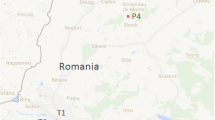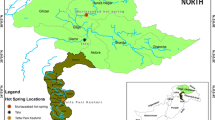Abstract
The microbial ecology associated with siliceous sinters was studied in five geochemically diverse Icelandic geothermal systems. Bacterial 16S rRNA clone libraries were constructed from water-saturated precipitates from each site resulting in a total of 342 bacterial clone sequences and 43 species level phylotypes. In near-neutral, saline (2.6–4.7% salinity) geothermal waters where sinter growth varied between 10 and ~300 kg year−1 m−2, 16S rRNA gene analyses revealed very low (no OTUs could be detected) to medium (9 OTUs) microbial activity. The most dominant phylotypes found in these waters belong to marine genera of the Proteobacteria. In contrast, in alkaline (pH = 9–10), meteoric geothermal waters with temperature = 66–96°C and <1–20 kg year−1m−2 sinter growth, extensive biofilms (a total of 34 OTUs) were observed within the waters and these were dominated by members of the class Aquificae (mostly related to Thermocrinis), Deinococci (Thermus species) as well as Proteobacteria. The observed phylogenetic diversity (i.e., number and composition of detected OTUs) is argued to be related to the physico-chemical regime prevalent in the studied geothermal waters; alkaliphilic thermophilic microbial communities with phylotypes related to heterotrophic and autotrophic microorganisms developed in alkaline high temperature waters, whereas halophilic mesophilic communities dominated coastal geothermal waters.





Similar content being viewed by others
References
Altschul SF, Gish W, Miller W, Myers EW, Lipman DJ (1990) Basic local alignment search tool. J Mol Biol 215:403–410
Bjornsdottir SH, Petursdottir SK, Hreggvidsson GO, Skirnisdottir S, Hjorleifsdottir S, Arnfinnsson J, Kristjansson JK (2009) Thermus islandicus sp nov., a mixotrophic sulfur-oxidizing bacterium isolated from the Torfajokull geothermal area. Int. J Syst Evol Microbiol 59:2962–2966
Blank CE, Cady SL, Pace NR (2002) Microbial composition of near-boiling silica depositing thermal springs throughout Yellowstone National Park. Appl Environ Microbiol 68:5123–5135
Boomer SM, Noll KL, Geesey GG, Dutton BE (2009) Formation of multilayered photosynthetic biofilms in an alkaline thermal spring in Yellowstone National Park, Wyoming. Appl Environ Microbiol 75:2464–2475
Brock TD, Freeze H (1969) Thermus aquaticus gen n. and sp. n., a nonsporulating extreme thermophile. J Bacteriol 98:289–297
Cady SL, Farmer JD (1996) Fossilization processes in siliceous thermal springs trends in preservation along thermal gradient. In: Evolution of hydrothermal ecosystem on Earth (and Mars?). Ciba Foundation, Wiley, pp 150–172
Chao A (1984) Nonparametric estimation of the number of classes in a population. Scand J Stat 11:265–270
Childs AM, Mountain BW, O’Toole R, Stott MB (2008) Relating microbial community and physicochemical parameters of a Hot Spring: Champagne Pool, Wai-o-tapu, New Zealand. Geomicrobiol J 25:441–453
Chung AP, Rainey FA, Valente M, Nobre MF, da Costa MS (2000) Thermus igniterrae sp nov and Thermus antranikianii sp. nov., two new species from Iceland. Int J Syst Evol Microbiol 50:209–217
Cole JR, Chai B, Marsh TL, Farris RJ, Wang Q, Kulam SA, Chandra S, McGarrell DM, Schmidt TM, Garrity GM, Tiedje JM (2003) The Ribosomal Database Project (RDP-II): previewing a new autoaligner that allows regular updates and the new prokaryotic taxonomy. Nucleic Acids Res 31:442–443
Cole JR, Chai B, Farris RJ, Wang Q, Kulam-Syed-Mohideen AS, McGarrell DM, Bandela AM, Cardenas E, Garrity GM, Tiedje JM (2007) The ribosomal database project (RDP-II): introducing myRDP space and quality controlled public data. Nucleic Acids Res 35:D169–D172
Derekova A, Mandeva R, Kambourova M (2008) Phylogenetic diversity of thermophilic carbohydrate degrading bacilli from Bulgarian hot springs. World J Microbiol Biotechnol 24:1697–1702
Eder W, Huber R (2002) New isolates and physiological properties of the Aquificales and description of Thermocrinis albus sp nov. Extremophiles 6:309–318
Farmer JD, DesMarais DJ (1999) Exploring for a record of ancient Martian life. J Geophys Res 104:26977–26995
Flores GE, Liu Y, Ferrera I, Beveridge TJ, Reysenbach A-L (2008) Sulfurihydrogenibium kristjanssoni sp nov., a hydrogen- and sulfur-oxidizing thermophile isolated from a terrestrial Icelandic hot spring. Int J Syst Evol Microbiol 58:1153–1158
Fouke BW, Bonheyo GT, Sanzenbacher B, Frias-Lopez J (2003) Partitioning of bacterial communities between travertine depositional facies at Mammoth Hot Springs, Yellowstone National Park, USA. Can J Earth Sci 40:1531–1548
Guindon S, Gascuel O (2003) A simple, fast, and accurate algorithm to estimate large phylogenies by maximum likelihood. Syst Biol 52:696–704
Hjorleifsdottir S, Skirnisdottir S, Hreggvidsson GO, Holst O, Kristjansson JK (2001) Species composition of cultivated and noncultivated bacteria from short filaments in an Icelandic hot spring at 88°C. Microbiol Ecol 42:117–125
Hreggvidsson GO, Skirnisdottir S, Smit B, Hjorleifsdottir S, Marteinsson VT, Solveig Petursdottir S, Kristjansson JK (2006) Polyphasic analysis of Thermus isolates from geothermal areas in Iceland. Extremophiles 10:563–575
Huber R, Eder W, Heldwein S, Wanner G, Huber H, Rachel R, Stetter KO (1998) Thermocrinis ruber gen nov., sp. nov., a pink-filament-forming hyperthermophilic bacterium isolated from Yellowstone national Park. Appl Environ Microbiol 64:3576–3583
Huber T, Faulkner G, Hugenholtz P (2004) Bellerophon: a program to detect chimeric sequences in multiple sequence alignments. Bioinformatics 20:2317–2319
Hudson JA, Morgan HW, Daniel RM (1987) Thermus filiformis sp nov., a filamentous caldoactive bacterium. Int J Syst Bacteriol 37:431–436
Hugenholtz P, Pitulle C, Hershberger KL, Pace NR (1998) Novel division level bacteria diversity in a Yellowstone hot spring. J Bacteriol 180:366–376
Hurst CJ, Crawford RL, Knudsen GR, McInernery MJ, Stetzenbach LD (2002) Manual of environmental microbiology. ASM Press, Washington DC
Inagaki F, Hayashi S, Doi K, Motomura Y, Izawa E, Ogata S (1997) Microbial participation in the formation of siliceous deposits from geothermal water and analysis of the extremely thermophilic bacterial community. FEMS Microbiol Ecol 24:41–48
Konhauser KO, Phoenix VR, Bottrell SH, Adams DG, Head IM (2001) Microbial-silica interactions in Icelandic hot springs sinter: possible analogues for some Precambrian siliceous stromatolites. Sedimentology 48:415–433
Kristjansson JK, Alfredsson GA (1983) Distribution of Thermus spp in Icelandic hot springs and a thermal gradient. Appl Environ Microbiol 45:1785–1789
Kristjansson JK, Hjorleifsdottir S, Merteinsson VT, Alfredsson GA (1994) Thermus scotoductus, sp. nov., a pigment-producing thermophilic bacterium from hot tap water in Iceland and including Thermus sp. X-1. Syst Appl Microbiol 17:44–50
Madigan M, Martinko J (2005) Brock biology of microorganisms, 11th edn. Prentice Hall, pp 1088
Meyer-Dombard DR, Shock EL, Amend JP (2005) Archaeal and bacterial communities in geochemically diverse hot springs of Yellowstone National Park USA. Geobiology 3:211–227
Nazina TN, Tourova TP, Poltaraus AB, Novikova EV, Grigoryan AA, Ivanova AE, Lysenko AM, Petrunyaka VV, Osipov GA, Belyaev SS, Ivanov MV (2001) Taxonomic study of aerobic thermophilic bacilli: descriptions of Geobacillus subterraneus gen. nov., sp. nov., and Geobacillus uzenensis sp. nov. from petroleum reservoirs and transfer of Bacillus stearothermophilus, Bacillus thermocatenulatus, Bacillus thermoleovorans, Bacillus kaustophilus, Bacillus thermoglucosidasius and Bacillus thermodenitrificans to Geobacillus as the new combinations G. stearothermophilus, G. thermocatenulatus, G. thermoleovorans, G. kaustophilus, G. thermoglucosidasius, and G. thermodenitrificans. Int J Syst Evol Microbiol 50:1331–1337
Petursdottir SK, Hreggvidsson GO, Da-Costa MS, Kristjansson JK (2000) Genetic diversity analysis of Rhodothermus reflects geographical origin of the isolates. Extremophiles 4:267–274
Petursdottir SK, Bjornsdottir SH, Hreggvidsson GO, Hjorleifsdottir S, Kristjansson JK (2009) Analysis of the unique geothermal microbial ecosystem of the Blue Lagoon. FEMS Microbiol Ecol 70:425–432
Purcell D, Sompong U, Yim LC, Barraclough TG, Peerapornpisal Y, Pointing SB (2007) The effects of temperature, pH and sulphide on the community structure of hyperthemophilic streamers in hot springs of northern Thailand. FEMS Microbiol Ecol 60:456–466
Reysenbach A-L, Wickham GS, Pace NR (1994) Phylogenetic analysis of the hyperthermophilic pink filament community in Octopus Spring, Yellowstone National Park. Appl Environ Microbiol 60:2113–2119
Sambrook J, Fritsch EF, Maniatis T (1989) Molecular cloning. A laboratory manual. Cold Spring Harbor Laboratory Press, Cold Spring Harbor
Schloss PD, Handelsman J (2005) Introducing DOTUR, a computer program for defining operational taxonomic units and estimating species richness. Appl Environ Microbiol 71:1501–1506
Shannon CE, Weaver W (1949) The mathematical theory of communication. University of Illinois Press, Champaign
Skirnisdottir S, Hreggvidsson GO, Hjörleifsdottir S, Marteinsson VT, Petursdottir SK, Holst O, Kristjansson JK (2000) Influence of sulfide and temperature on species composition and community structure of hot spring microbial mats. Appl Environ Microbiol 66:2835–2841
Squyres SW, Arvidson RE, Ruff S, Gellert R, Morris RV, Ming DW, Crumpler L, Farmer JD, Des Marais DJ, Yen A, McLennan SM, Calvin W, Bell JF III, Clark BC, Wang A, McCoy TJ, Schmidt ME, de Souza Jr PA (2008) Detection of silica-rich deposits on Mars. Science 320:1063–1067
Takacs CD, Ehringer M, Favre R, Cermola M, Eggertson G, Palsdottir A, Reysenbach A-L (2001) Phylogenetic characterisation of the blue filamentous bacterial community from and Icelandic geothermal spring. FEMS Microbiol Ecol 35:123–128
Takacs-Vesbach CD, Mitchell K, Jackson-Weaver O, Reysenbach A-L (2008) Volcanic calderas delineate biogeographic provinces amongst Yellowstone thermophiles. Environ Microbiol 10:1681–1688
Tobler DJ, Stefansson A, Benning LG (2008) In situ grown silica sinters in Icelandic geothermal areas. Geobiology 6:481–502
Toporski JKW, Steele A, Westall F, Thomas-Keprta KL, McKay DS (2002) The simulated silicification of bacteria—new clues to the modes and timing of bacterial preservation and implications for the search for extraterrestrial microfossils. Astrobiology 2:1–26
Ward DM, Santegoeds CM, Nold SC, Ramsing NB, Ferris MJ, Bateson MM (1997) Biodiversity within hot springs microbial communities: molecular monitoring of enrichment cultures. Antoine Leeuwenhoek 71:143–150
Yamamoto H, Hiraishi A, Kato K, Chiura HX, Maki Y, Shimizu A (1998) Phylogenetic evidence for the existence of novel thermophilic bacteria in hot spring sulphur-turf microbial mats in Japan. Appl Environ Microbiol 64:1680–1687
Acknowledgments
The authors thank Matthew Stott and Bruce Mountain from Wairakei Research Centre, GNS Science, Taupo, New Zealand for laboratory access and technical assistance with the construction of 16S rDNA clone libraries. DJT would like to acknowledge Xavier Bailley (INRA Clermont-Ferrand, Saint Genès Champanelle, France) for initial help with sequence analysis. Financial support via a PhD fellowship (DJT) from the Earth and Biosphere Institute (University of Leeds, UK), and a UK Royal Society research grant (LGB) to support work at GNS are acknowledged.
Author information
Authors and Affiliations
Corresponding author
Additional information
Communicated by M. da Costa.
Rights and permissions
About this article
Cite this article
Tobler, D.J., Benning, L.G. Bacterial diversity in five Icelandic geothermal waters: temperature and sinter growth rate effects. Extremophiles 15, 473–485 (2011). https://doi.org/10.1007/s00792-011-0378-z
Received:
Accepted:
Published:
Issue Date:
DOI: https://doi.org/10.1007/s00792-011-0378-z




